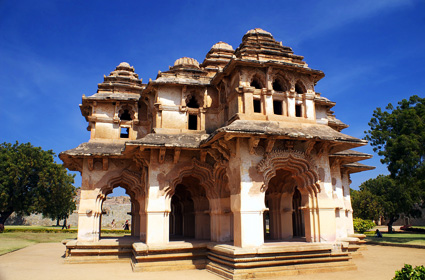Contribute
| South Asian Art - In Memory Of Prashant H. Fadia |
A compilation
04/27/2008
The story of Vijayanagar and its architecture takes us back to the 14th Century. In 1310 A.D., Malik Kafur, the famous general of Alla-ud-din Khilji, Sultan of Delhi swept down the One of the richest cities in the world at this time, it is noted for its palaces and enormous gateways. Built with a combination of Dravidic temple architecture and, for buildings with no religious significance, a mixture of dravida and local Islamic styles, the city is built on a site associated with both Shiva and Vishnu. It is also linked to Rama, the avatar of Vishnu and hero of the ancient epic, the Ramayana. Its most important ruler was Krishnadevaraya, a great patron of the arts and literature who is credited with building many major monuments and temples. The The temples of Hampi are famous for their large dimensions, florid ornamentation, both in painting and carving, majestic pillars, magnificent pavilions and a great wealth of religious and mythological depictions, including subjects from the Ramayana and the Mahabharata.
The Vijayanagara style of architecture relied heavily on the availability of natural resources, namely granite, which was the material used primarily by the Sangamas. Other dynasties employed the softer schist rock, suitable for ornate carvings. Many of the palaces have long since disappeared, as the kings used wood and bricks in their construction. Some brickwork is still visible on the gates to the temple courtyards.
The Hampi Bazaar, runs between
You may also access this article through our web-site http://www.lokvani.com/
